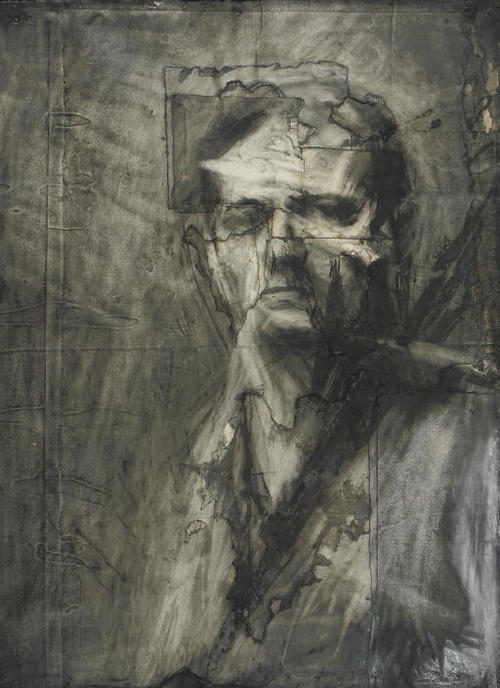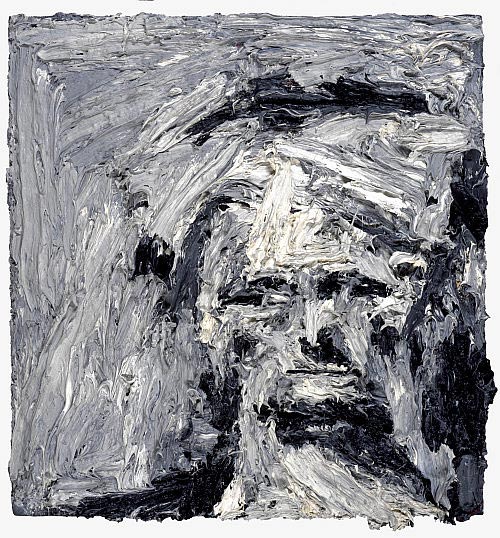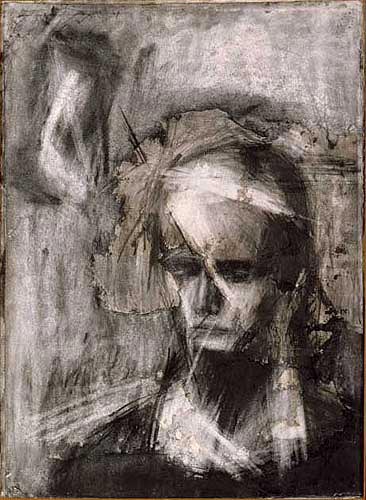| Frank Auerbach | |
|---|---|
 |
|
| Born | Apr. 29, 1931 Germany |
| Nationality | British (naturalized) German-born |
| Education | Bunce Court School |
| Field | Painting |
| Works | View Complete Works Portrait of Julia, c. 1960 Head of E.O.W. IV, 1961 |
Frank Auerbach is one of today’s leading international artists. His reputation and art first came to wide public attention in 1959 when the British arts review magazine “X” published a feature story on his work.
Auerbach had his first opening in 1956 at the Beaux Arts Gallery in London. His work continued to attract interest among the world art community in the early 1960s. He remains a working artist and major figure today. His reputation as an artist is currently growing, and recent sales of his work have brought surprisingly high prices.
Tragic Childhood
Auerbach was born to Jewish parents in Germany in 1931. His parents sensed the terrible events that were developing during the rise of Hitler and the Nazi regime, and so made arrangements to get their son out of the country. He arrived in England in 1939, but his parents remained behind and perished in Nazi death camps. Auerbach became a British citizen in 1947.
Difficult to Categorize
Auerbach’s work is often mistaken as expressionism, but it would be more proper to categorize his art as figurative. Like an expressionist, Auerbach’s paintings are not representational, or the visual equivalent of his subjects – which are mostly portraits and city scenes. Rather, he seeks to “resolve the being” of his subjects out of a “disordered environment.”
Thus, what we see in Auerbach’s work are portraits which are vaguely human, but never definitely outlined. His images are rendered chaotic with extremely heavy applications of paint and thick brush strokes, smeary attacks, bizarre angles, blurred edges, and so forth. One art critic described his work as “a sudden paroxysm.”
Inspirations
 Like many artists, Auerbach favors painting the same subject over and over again. He has specific models which he has painted hundreds of times. Perhaps his most frequent model is a person he identifies as “E.O.W.” – this is widowed actress Estella Olive West. Other extremely frequent subjects are his wife, Julia Auerbach and Joan Yardley Mills.
Like many artists, Auerbach favors painting the same subject over and over again. He has specific models which he has painted hundreds of times. Perhaps his most frequent model is a person he identifies as “E.O.W.” – this is widowed actress Estella Olive West. Other extremely frequent subjects are his wife, Julia Auerbach and Joan Yardley Mills.
Estella West was Auerbach’s mistress of 23 years, and it was she who inspired him to begin his practice of painting the same subject multiple times. West is said to have posed for “countless hours” for a single painting. West also reports that Auerback would spend hours or days on a single aspect of a portrait only to often scrap the whole effort and start over.
While his portraits are abstract and figurative, Auerbach is strongly influenced by classical artists, especially Rembrandt, Titian and Rubens. He has rendered his own versions of “Bacchus and Ariadne” by Titian and “Samson and Delilah” by Rubens.
In the 1950s, Auerbach’s paintings faced a somewhat peculiar obstacle – the paints he used were so heavy and applied so thickly, it made hanging them difficult because the paint would drop off. It was a practical problem, but also caused some art critics to label his works “grotesque” and “obtrusive.”
Other Subjects and Influences
 Auerbach’s other favorite subject is the location near where he lives, which is the Camden area of London. This is where he maintains his studio and has worked there for most of his professional career. Auerbach is well known for his prolific output. He paints “seven days a week, 365 days per year” he told a reporter for the British newspaper, “The Guardian.”
Auerbach’s other favorite subject is the location near where he lives, which is the Camden area of London. This is where he maintains his studio and has worked there for most of his professional career. Auerbach is well known for his prolific output. He paints “seven days a week, 365 days per year” he told a reporter for the British newspaper, “The Guardian.”
Auerbach’s work can also said to be influenced by his interest in acting, theater, and drama. In fact, Auerbach nearly pursued a career in acting rather than art. When he was a young man, he had a role in at least one play, Peter Ustinov’s “House of Regrets.”
An artist who was a major influence on the development of Auerbach’s style was David Bomberg, a British cubist and futurist under whom Auerbach studied at the Borough Polytechnic in London. Auerbach became friends with a fellow student under Bomberg, Leon Kossoff, an expressionist of some degree and who also influenced Auerbach.
Today Auerbach’s paintings have surprised some in the art community by commanding high monetary values. For example, his famous 1961 E.O.W. portrait recently sold at an auction by Bonham’s for 860,000 British pounds, which is about $1.3 million. One of his simple charcoal drawings might bring $50,000 at any given sale.
Auerbach continues to produce at age 82. In 2001, a television film was made on his life and work which aired on BBC. His international reputation is significant, but only time will tell if his work will enjoy lasting influence.